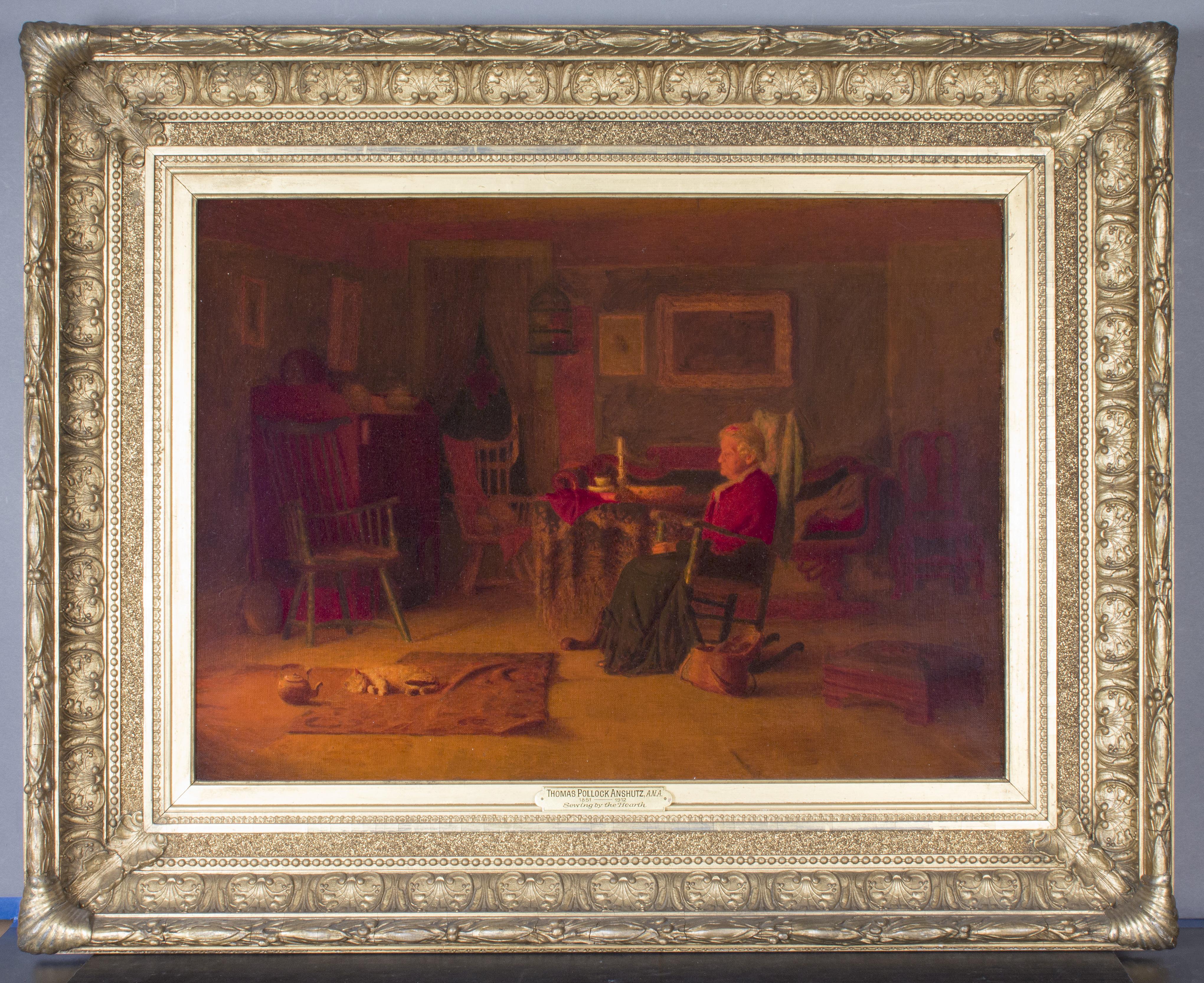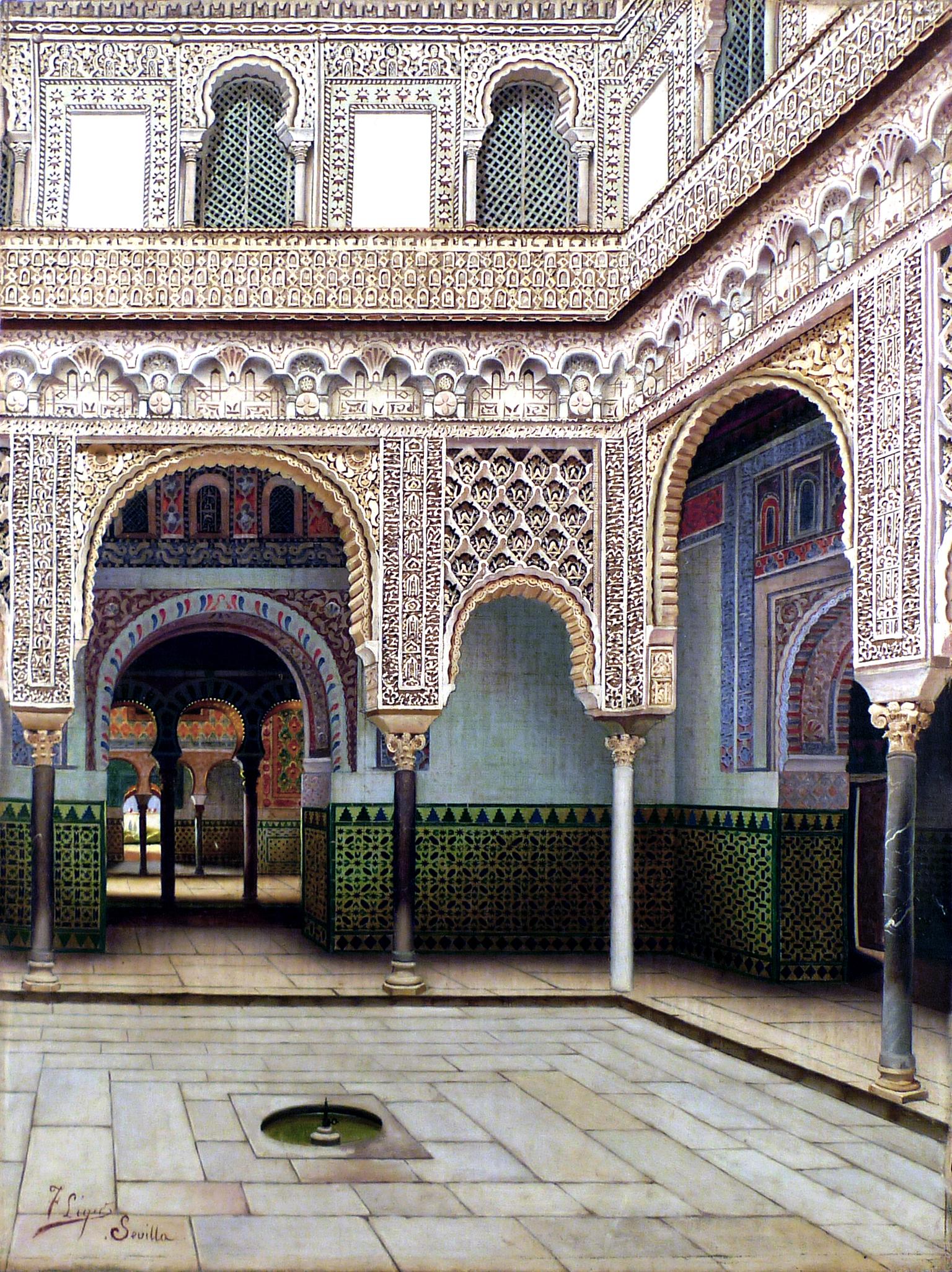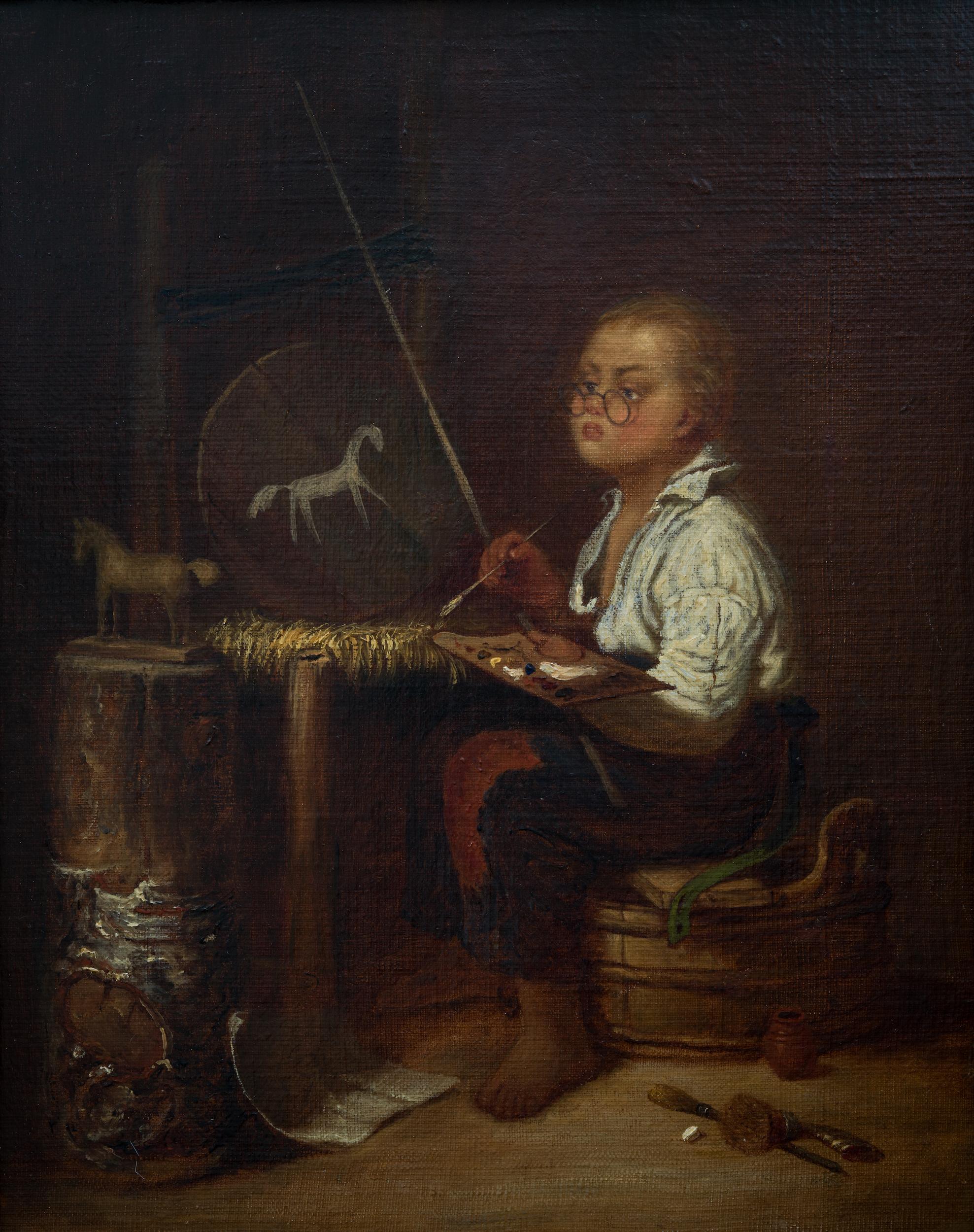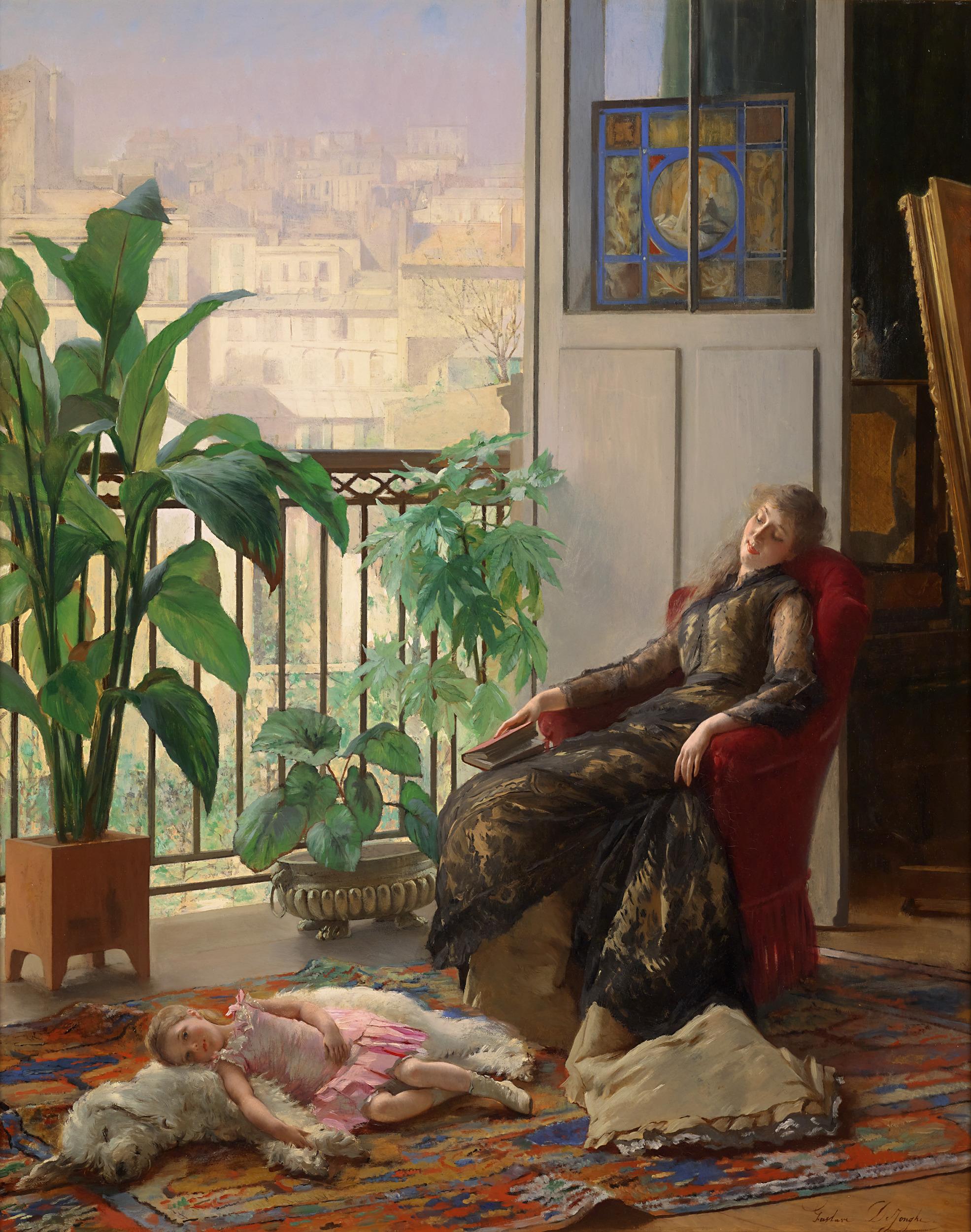Items Similar to The Cardinal's Visit
Want more images or videos?
Request additional images or videos from the seller
1 of 14
Salvador Sánchez BarbudoThe Cardinal's Visit1902
1902
About the Item
SALVADOR SÁNCHEZ BARBUDO
Spanish, 1857 - 1917
THE CARDINAL'S VISIT
signed, located and dated "Barbudo / ROMA 1902" (lower right)
oil on canvas
22 x 33-2/3 inches (55.5 x 85.5 cm.)
framed: 36-1/2 x 48-1/4 inches (92.5 x 122.5 cm.)
PROVENANCE
Private Collection, Munich
LITERATURE
Visita con el cardenal combines the two most salient characteristics of Sánchez-Barbudo's work: the search for novelty of theme and narrative content, and the use of minutely detailed brushwork and luminosity. Sánchez-Barbudo specialised in elaborate 'costume pictures', delighting the viewer with impressive details finely rendered with dazzling technical virtuosity.
Here, Sánchez-Barbudo depicts a well-to-do bourgeois family receiving a cardinal in their home. The interior, sumptuously furnished in the rococo style, along with the rich costumes and fabrics, are beautifully observed. Yet beyond the high technique lavished upon the composition, the treatment is comic and full of character and suffused with a gently satirising anti-clericalism.
The cardinal, far from getting the attention he expects, is, literally, sidelined, his expression and body language showing his pique. There is no doubt that contemporary collectors and spectators took pleasure in the sight of noble self-respecting figureheads of the church being brought back down to earth. The comedy was appealing, and the message suited the prevailing political mood of an increasingly secular middle-class buying public.
Salvador Sánchez Barbudo was born on March 14, 1857 in Jerez de la Frontera (Cádiz). He was one of the most important Spanish artists of the "casacón" genre, who followed the Fortuny tradition in Rome. During his childhood he was under the protection of the Marquis del Castillo and in 1875 he moved to Seville where he attended the School of Fine Arts, becoming a disciple of José Villegas.
He visited Rome with Villegas in 1882, settling in the Eternal City. In 1884 he sent the monumental canvas titled Hamlet to Spain. Last scene, with which he won a second medal at the National Exhibition of the same year. Practically all of Sánchez Barbudo's work consists of tableautins and anecdotal genre scenes that were very successful among the bourgeoisie of the time. He was extremely prolific and his works flooded the European and American markets. His canvases show extraordinary technical skill in their precise and summary brushwork, and a strong decorative sense. In a very personal way he combined Fortuny's "precious" heritage with a meticulous and vibrant technique that blurs forms.
Sánchez Barbudo was also an excellent watercolorist and engraver, as well as a portraitist of highly talented types. He died in Rome on November 28, 1917.
- Creator:Salvador Sánchez Barbudo (1857 - 1917, Spanish)
- Creation Year:1902
- Dimensions:Height: 21.86 in (55.5 cm)Width: 33.67 in (85.5 cm)
- More Editions & Sizes:55.5 x 85.5 cm.Price: $87,283
- Medium:
- Movement & Style:
- Period:
- Condition:
- Gallery Location:Madrid, ES
- Reference Number:1stDibs: LU1281114102392
About the Seller
5.0
Vetted Seller
These experienced sellers undergo a comprehensive evaluation by our team of in-house experts.
Established in 1977
1stDibs seller since 2019
21 sales on 1stDibs
Typical response time: 2 hours
- ShippingRetrieving quote...Ships From: Madrid, Spain
- Return PolicyA return for this item may be initiated within 14 days of delivery.
More From This SellerView All
- "The Florence Sisters", 19th Century Oil on Canvas, Spanish Artist José VillegasLocated in Madrid, ESJOSÉ VILLEGAS Y CORDERO Spanish 1844 - 1921 "The Florence Sisters" signed "Villegas" (lower left) oil on canvas 33-1/2 X 40-1/2 inches (84.5 X 102.5 cm.) PROVENANCE Private Collector, Seville, Spain José Villegas Cordero (Seville, August 26, 1844-Madrid, November 9, 1921) was a Spanish painter. He directed the Prado Museum between 1901 and 1918. Biography He was the brother of the painter Ricardo Villegas Cordero. He began his apprenticeship very young with José María Romero, with whom he remained for two years until entering the School of Fine Arts in Seville, where he was under the tutelage of Eduardo Cano. In 1860, when he was only 16 years old, he sold his work Little Philosophy for 2,000 reais at the Seville Exhibition. In 1867 he traveled to Madrid, where he entered Federico Madrazo's studio. There he established friendship with painters Eduardo Rosales and Fortuny. He went regularly to the Prado where he copied Velázquez, from whom he acquired spontaneity and the use of color for his technique. Finally, and out of admiration for Fortuny's orientalist painting, he returned to Seville and organized an excursion to Morocco. At the end of 1868 he decided to travel to Rome accompanied by the painters Rafael Peralta and Luis Jiménez Aranda...Category
Late 19th Century Realist Figurative Paintings
MaterialsCanvas, Oil
- "Interior of Alcazar of Seville", Early 20th Century oil on canvas by F. LigerBy Fernando Liger HidalgoLocated in Madrid, ESFERNANDO LIGER HIDALGO Spanish , 1880 – 1945 "Interior of Alcazar of Seville" Signed & located "F. Liger, Sevilla " (lower left) Oil on canvas 2...Category
1920s Realist Interior Paintings
MaterialsCanvas, Oil
- "Wedding Ceremony in Tebriz", 19th Century Oil on Canvas by Mohamed Ali NaqashLocated in Madrid, ESMOHAMED ALI NAQASH Iraqi, 19th - 20th Century WEDDING CEREMONY IN TEBRIZ signed in arabic and inscribed Mohamed Ali al-Naqash / Tabrizi lower right oil on c...Category
Early 1900s Realist Figurative Paintings
MaterialsCanvas, Oil
- "Ballet Lessons", 20th Century Oil on Canvas by Sebastián Llobet Ribas, SpanishLocated in Madrid, ESSEBASTIÁN LLOBET RIBAS Spanish, 1887 - 1975 signed "Llobet Ribas" (lower right) signed again "Llobet Ribas" (on the reverse) oil on canvas 32 x 25-3/4 inches (80.5 x 65 cm.) unframed PROVENANCE Private Collector, Barcelona Painter and draftsman of the twentieth century, born in Barcelona in 1887. He attended the Fine Arts Schools and was a disciple of Vicente Climent. He participated in the Self-Portraits Exhibition held in 1907, in the Drawing Exhibition in the Sala Parés in 1910, in several of the Spring and International Exhibition, and in the National Exhibition of 1942 and 1944 in Barcelona and in 1950 in Madrid. In the 1951 Exhibition of the Circulo de Bellas Artes de Palma de Mallorca, he obtained a medal for the set of drawings...Category
1930s Realist Figurative Paintings
MaterialsCanvas, Oil
- "Partida de Tresillo", Late 19th Century Oil on Canvas by José Jiménez ArandaLocated in Madrid, ESJOSÉ JIMÉNEZ ARANDA Spanish, 1837 - 1903 PARTIDA DE TRESILLO signed, located & dated “J. Aranda / Madrid. 1893.” (lower right) oil on canvas 31-1/2 x 39-1/3 inches (80 x 100 cm) framed: 40-1/3 x 48 inches (102.5 x 122 cm.) BIBLIOGRAPHY - This picture being mentioned and illustrated in “LA ILUSTRACION ESPAÑOLA Y AMERICANA”, Madrid, September 15, 1895 - José Jiménez Aranda, 1837-1903: Centro Cultural El Monte, Seville, October 2005, illustrated p. 102 PROVENANCE Private Collection, USA José Jiménez Aranda (7 February 1837 – 6 May 1903) was a Spanish painter and brother of the painters Luis Jiménez...Category
1890s Realist Figurative Paintings
MaterialsOil, Canvas
- "The Barber of Seville", Early 20th Century Oil on Canvas by José VillegasLocated in Madrid, ESJOSÉ VILLEGAS CORDERO Spanish, 1844 - 1921 THE BARBER OF SEVILLE signed & dated "J. Villegas. / Junio 1913." (lower left) oil on canvas 19-3/8 x 28-3/4 inches (49 x 73 cm.) framed: 27-1/2 x 36-3/4 inches (69.5 x 93 cm.) PROVENANCE Private Collector, Seville, Spain José Villegas Cordero (Seville, August 26, 1844-Madrid, November 9, 1921) was a Spanish painter. He directed the Prado Museum between 1901 and 1918. He was the brother of the painter Ricardo Villegas Cordero. He began his apprenticeship very young with José María Romero, with whom he remained for two years until entering the School of Fine Arts in Seville, where he was under the tutelage of Eduardo Cano. In 1860, when he was only 16 years old, he sold his work Little Philosophy for 2,000 reais at the Seville Exhibition. In 1867 he traveled to Madrid, where he entered Federico Madrazo's studio. There he established friendship with painters Eduardo Rosales and Fortuny. He went regularly to the Prado where he copied Velázquez, from whom he acquired spontaneity and the use of color for his technique. Finally, and out of admiration for Fortuny's orientalist painting, he returned to Seville and organized an excursion to Morocco. At the end of 1868 he decided to travel to Rome accompanied by the painters Rafael Peralta and Luis Jiménez Aranda...Category
1910s Realist Figurative Paintings
MaterialsCanvas, Oil
You May Also Like
- Sewing By The Hearth: interior scene w/ cat by Thomas Anshutz, student of EakinsBy Thomas P AnshutzLocated in Philadelphia, PAThomas Pollock Anshutz (American, 1851-1912) Sewing by the Hearth, c. 1884 Original frame Oil on canvas, 17 x 24 inches; Framed: 34 x 27 inches Label (handwritten in ink) on stretcher verso: “Artist Thos Anshutz” Label on backing verso: (printed) “PORTLAND MUSEUM OF ART”; [...] (typewritten) “Thomas Pollock Anshutz/American, 1851 1912/INTERIOR/oil on canvas/stretcher: 17 x 23 15/16 inches/not signed/COLLECTION OF MRS. NORMAN B...Category
1880s Realist Interior Paintings
MaterialsCanvas, Oil
- Oil Painting Called "The Young Artist" by Swedish Johan Christoffer BoklundLocated in Stockholm, SEIntroducing a captivating oil painting by Johan Christoffer Boklund (1817-1880). The artwork depicts a young boy practicing his painting skills. Seated beside him is a wooden horse t...Category
19th Century Realist Interior Paintings
MaterialsCanvas, Oil, Board
- Afternoon Repose By Gustave Léonard De JongheLocated in New Orleans, LAGustave Léonard de Jonghe 1829-1893 | Flemish Afternoon Repose (The Artist's Studio — Antibes) Signed “Gustave De Jonghe” (lower right) Oil on canv...Category
Late 19th Century Realist Figurative Paintings
MaterialsCanvas, Oil
- Parisian Chandeliers, landscape art, original art, interior art, still-lifeLocated in Deddington, GBParisian Chandeliers by Lesley Ann Derks [2017] original Oil and enamel on canvas Image size: H:40 cm x W:50 cm Complete Size of Unframed Work: H:...Category
21st Century and Contemporary Realist Figurative Paintings
MaterialsEnamel
- Distrust - Contemporary, Figurative Painting, Window, Blue, Human, Female, MaleBy Radu RodidealLocated in Berlin, DEDistrust, 2012 Oil on canvas (Signed on reverse) 70.86 H x 70.86 W in 180 H x 180 W cm Radu Rodideal is interested in the atmosphere of his work. Human ...Category
2010s Realist Figurative Paintings
MaterialsCanvas, Oil
- The GossipsBy L. Clarence BallLocated in Missouri, MOL. Clarence Ball "The Gossips" 1885 Oil on Canvas Signed and Dated Site Size: approx 16 x 24 inches Framed Size: approx 23 x 31 inches Born in Mount Vern...Category
1880s Realist Interior Paintings
MaterialsCanvas, Oil



